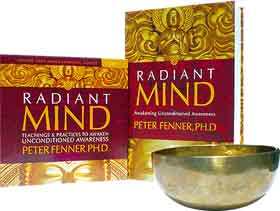Deb: What does meditation mean to you?
Peter: Meditation for me is the presencing of pure awareness. It’s simply being in the place where there’s nothing more that needs to be done. It’s the culmination of all searching of any type, and arriving at the point where there’s a sense of total completion. It’s the point where it’s impossible to conceive of anywhere further to go. We arrive at the point where there’s a dissolution of any notion of a path, of having been somewhere, and looking for a more preferable place to be. It’s a dissolution of being in any particular place at all. Meditation in this sense, is being connected with the unconditioned dimension of being.
Deb: How does that enable us to deal with issues within ourselves such as shadow issues, anger, fear—does meditation address those?
Peter: Meditation can address those issues and feelings. We have to clarify that I have just been describing what I would call natural meditation, which is effortless. Nothing is involved. It’s just the continual arising and presencing of what is, from a place in which there’s no point of reference within us. We are just a clearing within which the universe flows through. In natural meditation, there’s no technique, no meditator doing anything.
That’s different from what Tibetan Buddhism calls technical meditation, where there is something that we do. It’s a procedure, an activity that we insert into the flow of our experience in order to try to modify our experience. We want to produce a particular result, like reducing anger, frustration, or anxiety, in order to bring about an experience of peace, tranquility, clarity and so on.
When we’re using the term meditation as something that a person does, there are innumerable forms, designed for different people to produce different results. Meditation can be used to become more loving, reveal and integrate reactive emotions, heal physical illnesses, discover peace and tranquility, sharpen the intellect, see things with less projection. But this is different from the natural arising of real completion.
Ed: Many people who meditate want to achieve what you described as the arrival point.
Peter: Yes, but let me clarify that even the experience of “arriving” is something that occurs within the practice of traditional meditation. In natural meditation there’s really no arriving; we could say there is just being. The very idea of “arriving” also means we can become unstuck. That’s what continually happens in a traditional meditation practice. We start at a point where we feel that something is wrong, something is missing, something needs to be done, and we look to meditation as a method for arriving at a place of completion.
With meditation, an internal change happens in people’s experience: thinking slows down, a feeling of tranquility emerges, and our heart can open up. If we like what is happening, we might feel that, ah, we’ve arrived. We feel good. This is where we wanted our practice to take us.
But we still haven’t entered the space of natural meditation. We are still in time. Even when we’ve arrived, we’re still in time. We encounter a state within our meditation that lets us stop. We let go of all ambition and endeavor and finally come to rest, satisfied with what is. But because this is a conditioned state, it will invariably change. We will lose it. Things will change in the external environment. New sensations will arise in our body. New thoughts, images, and memories will come up. We’ll start to think about the future and how we will handle different situations. At some point we’ll see that we are no longer resting. We’ll figure that we’ve lost it. Wow that was great! What happened? What do I need to do now? We are thrown back into the project of recreating a goal and going after it. This is meditation as a project, and this is the way a lot of people engage in meditation. There’s a meditation, a meditator, and then the project, a particular way of practicing that’s meant to produce a particular outcome. This is different from natural meditation.
In natural meditation there’s nothing to do, whatsoever. There’s no notion of being on the path, nor any experience of having arrived, because there’s no point of reference. This is often called meditation without a point of reference, or the meditation that is no longer meditation.



